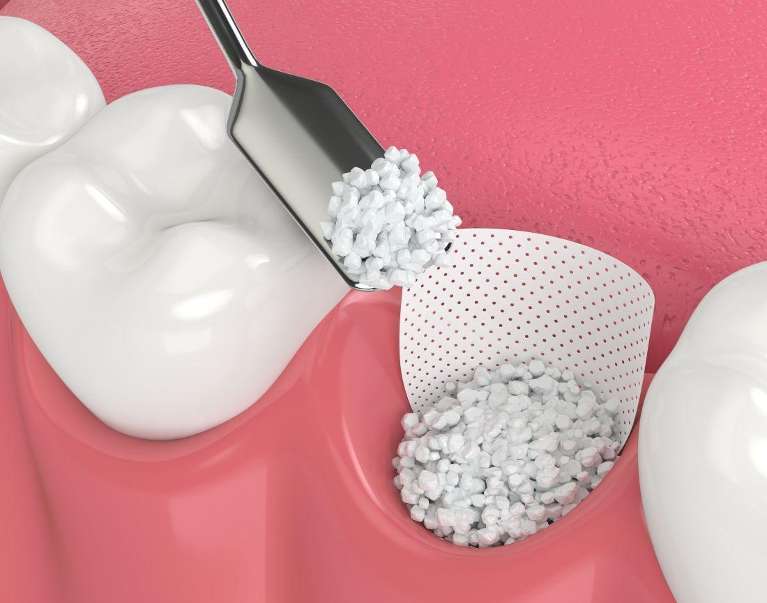
Waking up every day with missing teeth can be frustrating; you might avoid smiling at your neighbors or feel the need to cover your mouth when you’re talking to your coworkers. The unfortunate truth is that gaps in your smile can affect your self-esteem and how you interact with others.
At Dental Center of Wellington, we don’t want anyone to feel this way; that’s why we offer numerous options for restoring your smile’s function and beauty and boosting your confidence.
Dental implants in Royal Palm Beach are an excellent tooth replacement option, but sufficient bone density is necessary to support the implants. Without it, you may need a bone graft before your implant surgery.
So, what can you expect before, during, and after your bone grafting procedure? Let’s take a look.
What Is a Bone Graft?
This minor surgical procedure is designed to add bone to your jaw. The grafting material can be from a donor, an animal, or it might be synthetic. Your body uses this material as the framework to grow new bone, giving you a stable foundation for dental implants.
Common Reasons for a Dental Bone Graft
There are numerous reasons you might need a dental bone graft, including the following:
- To support a dental implant
- To add bone height to your upper jaw (sinus lift)
- To restore bone loss from missing teeth
- To help you heal after a traumatic mouth injury
- To repair structural issues in your jaw
- To improve tooth stability due to gum disease
The “Before” Phase: Preparing for Your Procedure
To determine whether you have sufficient jawbone density, your Royal Palm Beach dentist will examine the area and take x-rays. Then, they will discuss the procedure with you and answer any questions you have.
Pre-Operative Instructions
Depending on your unique situation, your dentist may:
- Ask you to stop taking certain medications before the procedure
- Prescribe antibiotics to reduce your infection risk
- Talk to you about wearing comfortable clothes and dealing with dental anxiety
The “During” Phase: The Bone Grafting Procedure
Your dental bone graft is the first step toward a complete smile, and our dental team will do everything possible to guide you through the process, keeping you calm and comfortable. We’ll numb the area before we begin; you won’t feel anything during the procedure.
A Step-by-Step Overview of the Procedure
The bone grafting procedure includes these steps:
- Your dentist will open your gum tissue to access the bone.
- Then, they will place the bone graft material into the area where you have insufficient bone density.
- To keep the graft material in place, they’ll add a special membrane to the area.
- They’ll stitch the area to close it and allow for healing.
The “After” Phase: Recovery and Healing
After your procedure is complete, it’s best to go home and rest for the remainder of the day. Your dentist will explain what to expect and provide guidance on how to care for your mouth. It’s normal for you to experience some swelling and minor bleeding.
Immediate Post-Operative Care (First 24-48 Hours)
For the first two days, here are some care tips to alleviate discomfort and encourage healing:
- Use ice packs to reduce facial swelling.
- Take over-the-counter pain relievers if needed.
- Eat soft foods like mashed potatoes, yogurt, and smoothies.
- Avoid hard and crunchy foods, as they can be harmful.
- Drink plenty of water and limit your intake of carbonated beverages and alcohol.
- Avoid drinking from a straw or brushing the surgical site.
- After 24 hours, gently rinse your mouth with warm salt water several times a day.
The Bone Grafting Healing Timeline
Your dental bone graft will take several months to heal; general healing guidelines are as follows:
- The first few weeks — Some swelling and discomfort are normal. For best results, follow your dentist’s instructions.
- Three to six months — During this phase, your bone graft is fusing with your natural bone.
- Six to nine months — Your newly-formed bone gets stronger; soon, you’ll be ready for a dental implant.
 Long-Term Recovery Tips
Long-Term Recovery Tips
To ensure the best possible outcomes, it’s essential to follow these long-term recovery tips:
- Keep scheduled appointments — Make sure to attend all follow-up appointments with your Royal Palm Beach dentist. That way, they can monitor your healing and check for signs of infection.
- Contact your dentist — Pay attention to any signs of infection, and if you’re experiencing severe pain, contact our office right away.
Looking for Dental Implants in Royal Palm Beach, FL?
If you’re ready to begin your bone grafting journey, or if you have questions about what dental implants can do for your smile, our experienced dental team is ready to take your call! At Dental Center of Wellington, our goal is to help you look forward to smiling again, and dental implants are a fantastic option that can do just that.
To schedule a consultation or appointment, please contact us at (561) 422-1020.
We look forward to hearing from you!

